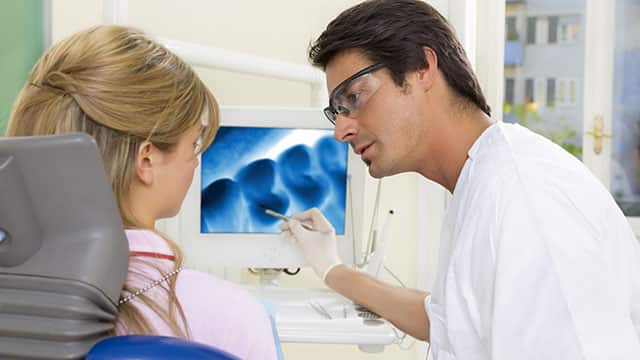What Causes Crooked Teeth?
Misaligned teeth can have a variety of causes, including:
- Genetics
Crooked teeth can be genetic. Crowding, jaw size, jaw shape, having too many teeth (hyperdontia), overbites, underbites, and poor tooth or palate development are some of the conditions that can be passed down in your family. - Poor Oral Hygiene
If you don't practice good oral hygiene, you could get gingivitis (the early stages of gum disease). According to the Journal of Dental Research, nearly half of adults over 30 in the US have some form of gum disease. Left untreated, gingivitis can develop into periodontitis. This more severe form of gum disease can cause your teeth to loosen, shift, or even fall out.
- Early baby tooth loss
If you lost a baby tooth early when you were a child, it could have allowed other teeth to shift into the area of loss, crowding the area where a permanent tooth would eventually come in. - Thumb sucking
If you were in the habit of sucking on your thumb (or toys, etc.) when you were a child, that could be a reason you have crooked teeth. - Tongue thrusting
When you swallow, your tongue is supposed to press against the roof of your mouth behind your front teeth. If you press your tongue on your teeth instead, that's called tongue thrusting. This habit, over time, can result in crooked teeth. - Malnutrition
Getting enough nutrients in your diet is important for the health and development of your body's muscles, bones, and tissue. If your body doesn't get what it needs, it could result in crooked teeth, amongst other potential health issues. - Mouth breathing
Mouth breathing in children may have an impact on tooth alignment. - Trauma
Injuries from sports and other accidents could cause your teeth to be misaligned.
What Are The Oral Health Benefits of Straight Teeth?
When your teeth are aligned, they tend to harbor fewer bacteria because they're easier for you to clean. Better oral hygiene will decrease your risk of tooth decay, periodontal disease, and your gums may support your teeth better when they aren't overlapping, too. You could also have a decreased risk of chipping, breaking, or wearing away your teeth when they fit together correctly. You may even experience less stress on your jaw from misaligned teeth.
How Do Orthodontists Fix Misaligned Teeth?
Your bones have two kinds of cells that do all the work to remodel your skeleton as needed. Osteoclasts break down old bone and deliver it into your bloodstream (resorption), and osteoblasts build your bone where it needs to be reinforced (ossification). When you're a child, you create bone faster, and the process slows as you age. In fact, according to Wheeless' Textbook of Orthopaedics, when you were in your first year of life, almost 100% of your skeleton was replaced, and as an adult, your bones remodel themselves at a rate of about 10% per year.
When orthodontists realign your teeth with the following devices, resorption and ossification are what allows for the movement and strengthening of your teeth in a new position.
- Braces
You're probably familiar with the wires, metal brackets, and rubber bands that make up traditional orthodontic hardware. This option is still a popular choice for straightening teeth because they work. However, their aesthetic, the fact that they make practicing good oral hygiene more complicated, and needing to go to the orthodontist every six weeks for adjustments has many people opting for clear aligners.
- Clear Aligners
Clear aligners are discreet, removable alternatives to metal braces. When you get these custom-made, clear plastic aligners, you'll receive several months' worth in advance, and you'll change them out at regular intervals to help shift your teeth into the proper position. According to the American Association of Orthodontists, each set of aligners is usually worn for 1-3 weeks. The entire series of aligners could take up to nine months or longer, depending on the amount of alignment needed.It is important to note that the American Dental Association discourages getting clear aligners directly from manufacturers in what's being called Do-It-Yourself (DIY) Orthodontics. Moving teeth is a medical procedure that should be done with the supervision of a licensed professional.
Learn more about the differences between clear aligners and braces.
- Retainer
If your teeth are only slightly crooked due to minor overcrowding, you may be able to get your teeth aligned using a retainer. Retainers are usually used to maintain the alignment of teeth after you wear braces, but for small adjustments, a retainer may be able to do the trick.
- Palatal expander
If your child's mouth is too small for their future adult teeth, their orthodontist may insert a palatal expander to widen the arch of their upper teeth. The expander will be fastened to your child's upper molars using dental cement. Over time, the orthodontist will use a special key during visits, placing gradual pressure on the upper jaw's left and right halves. This causes extra bone to grow between the two halves of the jaw, increasing the width of your child's mouth so their teeth can shift into the proper position. Expanders are mostly invisible, but your child may experience mild discomfort each time their expander is adjusted.
There's a long list of famous and highly successful people who are considered beautiful or eccentric because of their misaligned teeth. But even if you like the unique aesthetic that comes with your crooked teeth, it's important to note that they could cause problems for your oral health. Speak with your dental professional, and they will help you determine whether any of the above straightening options are right for you. Whatever it is you decide, we hope it makes you smile.
This article is intended to promote understanding of and knowledge about general oral health topics. It is not intended to be a substitute for professional advice, diagnosis or treatment. Always seek the advice of your dentist or other qualified healthcare provider with any questions you may have regarding a medical condition or treatment.
ORAL HEALTH QUIZ
What's behind your smile?
Take our Oral Health assessment to get the most from your oral care routine
ORAL HEALTH QUIZ
What's behind your smile?
Take our Oral Health assessment to get the most from your oral care routine
Join Us
Get the best of your oral health routine and take it to the next level with expert advice, recommendations, products and solutions and special offers.
Join Us
Get the best of your oral health routine and take it to the next level with expert advice, recommendations, products and solutions and special offers.















